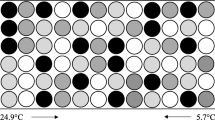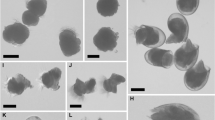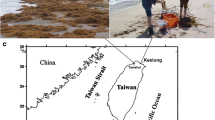Abstract
The fucoid Phyllospora comosa has sparked interest from the industry as a potential commercial aquaculture species. However, information on the feasibility of culturing this species, including maximising spawning and fertilisation, remains limited. This study aimed to identify optimal conditions for spawning and early development of P. comosa under laboratory conditions. We tested spawning and germination success across lunar phase (new moon vs full moon), temperature (15 °C, 18 °C, 21 °C), light (35 μmol photons m−2 s−1 vs 0 μmol photons m−2 s−1) and exposure (desiccated vs submerged). Lunar cycles were compared over three consecutive months. Fifty fertile P. comosa male and female thalli were collected from Port Fairy, Victoria, Australia, every 2 weeks to coincide with full and new moon phases from February to April 2017. Spawning of eggs and sperm was achieved in all treatment combinations. However, there was no consistent effect of lunar phase, light, temperature or exposure, with high temporal variability amongst treatment groups. Percentage germination after 24 h in static culture varied between 35 and 90%, and overall embryo mortality was high (> 65%) after 7 days, but did not differ amongst spawning cue treatments. The high mortality observed at day 7 did not appear to be linked to insufficient egg or sperm densities nor excess sperm (polyspermy). Overall results indicate flexibility in spawning conditions which is advantageous for integration into aquaculture.




Similar content being viewed by others
References
Andersson S, Kautsky L, Kalvas A (1994) Circadian and lunar gamete release in Fucus vesiculosus in the atital Baltic Sea. Mar Ecol Prog Ser 110:195–201
Brawley SH (1992) Fertilization in natural populations of the dioecious brown alga Fucus ceranoides and the importance of the polyspermy block. Mar Biol 113:145–157
Burridge TR (1990) Reproduction, development and growth in Phyllospora comosa, Seiroccus axillaris and Scytothalia dorycarpa (Seirococcaceae, Phaeophyta). PhD Thesis, Monash University, Melbourne
Burridge TR, Shir MA (1995) The comparative effects of oil dispersants and oil/dispersant conjugates on germination of the marine macroalga Phyllospora comosa (Fucales: Phaeophyta). Mar Pollut Bull 31:446–452
Burridge T, Clayton MN, Hallam ND (1993) Oogenesis and stalk mediated fertilization in Phyllospora comosa, (Labillardiere) C. Agardh, (Seirococcaceae, Phaeophyta). Bot Mar 36:223–233
Burridge T, Portelli T, Ashton P (1996) Effect of sewage effluents on germination of three marine brown algal macrophytes. Mar Freshw Res 47:1009–1014
Buschmann AH, Camus C, Infante J, Neori A, Israel Á, Hernández-González MC, Pereda SV, Gomez-Pinchetti JL, Golberg A, Tadmor-Shalev N, Critchley AT (2017) Seaweed production: overview of the global state of exploitation, farming and emerging research activity. Eur J Phycol 52:391–406
Campbell AH, Marzinelli EM, Verges A, Coleman MA, Steinberg PD (2014) Towards restoration of missing underwater forests. PLoS One 9:e84106
Camus C, Buschmann AH (2017) Macrocystis pyrifera aquafarming: production optimization of rope-seeded juvenile sporophytes. Aquaculture 468:107–114
Carl C, de Nys R, Lawton RJ, Paul NA (2014) Methods for the induction of reproduction in a tropical species of filamentous Ulva. PLoS One 9:e97396
Christie AO, Evans LV (1962) Periodicity in the liberation of gametes and zoospores of Enteromorpha intestinalis. Nature 193:193–194
Cole AJ, de Nys R, Paul NA (2015) Biorecovery of nutrient waste as protein in freshwater macroalgae. Algal Res 7:58–65
Creed JC, Norton TA, Kain JM (1997) Intraspecific competition in Fucus serratus germlings: the interaction of light, nutrients and density. J Exp Mar Biol Ecol 212:211–223
de Bettignies T, Wernberg T, Gurgel CFD (2018) Exploring the influence of temperature on aspects of the reproductive phenology of temperate seaweeds. Front Mar Sci 5:218
Drew KM (1949) Conchocelis-phase in the life-history of Porphyra umbilicalis (L.) Kuetz. Nature 164:748–749
Falace A, Kaleb S, De La Fuente G, Asnaghi V, Chiantore M (2018) Ex situ cultivation protocol for Cystoseira amentacea var. stricta (Fucales, Phaeophyceae) from a restoration perspective. PLoS One 13:e0193011
FAO (2018) The state of food insecurity in the world 2018. Building climate resiliance for food secuity and nutrition. FAO, Rome
Flavin K, Favin N, Flahive B (2013) Kelp farming manual: a guide to the processes techniques and equipment for farming kelp in the New England waters. Ocean Approved LLC, Saco, ME, USA pp 1–123
Fleming AE (1995) Growth, intake, feed conversion efficiency and chemosensory preference of the Australian abalone, Haliotis rubra. Aquaculture 132:297–311
Fletcher RL (1980) Studies of the recently introduced brown alga Sargassum muticum (Yendo) Fensholt. III. Periodicity in gamete release and “incubation” of early germling stages. Bot Mar 31:425–432
FRDC (2010) Overview of the Australian fishing and aquaculture industry: present and future. The National Fishing and Aquaculture RD&E Strategy, Fisheries Research and Development Corporation, Canberra pp 30–115
FRDC (2015) Seaweed farming to boost finfish aquaculture. FISH Archive, September 21:23
Hales JM, Fletcher RL (1990) Studies of the recently introduced brown alga Sargassum muticum (Yendo) Fensholt. V. Receptacle initiation and growth, and gamete release in laboratory culture. Bot Mar 33:241–249
Halpern BS, Walbridge S, Selkoe KA, Kappel CV, Micheli F, D’Agrosa C, Bruno JF, Casey KS, Ebert C, Fox HE, Fujita R, Heinemann D, Lenihan HS, Madin EM, Perry MT, Selig ER, Spalding M, Steneck R, Watson R (2008) A global map of human impact on marine ecosystems. Science 319:948–952
Hoyt WD (1927) The periodic fruiting of Dictyota and its relation to the environment. Am J Bot 14:592–619
Hwang EK, Park CS, Baek JM (2006) Artificial seed production and cultivation of the edible brown alga, Sargassum Fulvellum (Turner) C. Agardh: developing a new species for seaweed cultivation in Korea. J Appl Phycol 18:251–257
Kerrison P, Le HN (2015) Environmental factors on egg liberation and germling production of Sargassum muticum. J Appl Phycol 28:481–489
Kevekordes K, Clayton MN (1996) Using developing embryos of Hormosira banksii (Phaeophyta) as a marine bioassay system. Int J Plant Sci 157:582–585
Lorbeer AJ, Tham R, Zhang W (2013) Potential products from the highly diverse and endemic macroalgae of Southern Australia and pathways for their sustainable production. J Appl Phycol 25:717–732
Loureiro R, Gachon CM, Rebours C (2015) Seaweed cultivation: potential and challenges of crop domestication at an unprecedented pace. New Phytol 202:489–492
Lüning K (1981) Egg release in gametophytes of Laminaria saccharina: induction by darkness and inhibition by blue light and U.V. Br Phycol J 16:379–393
Lüning K, Pang S (2003) Mass cultivation of seaweeds: current aspects and approaches. J Appl Phycol 15:115–119
Lüning K, Kadel P, Pang S (2008) Control of reproduction rhythmicity by environmental and endogenous signals in Ulva pseudocurvata (Chlorophyta). J Phycol 44:866–873
Marzinelli EM, Campbell AH, Vergés A, Coleman MA, Kelaher BP, Steinberg PD (2013) Restoring seaweeds: does the declining fucoid Phyllospora comosa support different biodiversity than other habitats? J Appl Phycol 26:1089–1096
McKenzie PF, Bellgrove A (2006) No outbreeding depression at a regional scale for a habitat-forming intertidal alga with limited dispersal. Mar Freshw Res 57:655–663
Müller DG (1962) Über jahres- und lunarperiodische Erscheinungen bei einigen Braunalgen. Bot Mar 4:140–155
Mulvaney W, Jahangard S, Turchini G, Krsinich A, Lillie P, Winberg P, Ingram BA (2013) Offshore abalone farming development in Port Phillip Bay: a pilot study. Fisheries Victoria Research Report Series 65:31
Mulvaney WJ, Jahangard S, Ingram BA, Turchini GM, Winberg PC (2015) Recovery of omega-3 profiles of cultivated abalone by dietary macroalgae supplementation. J Appl Phycol 27:2163–2171
Nilsen G, Nordby O (1975) A sporulation-inhibiting substance from vegetative thalli of the green alga Ulva mutalilis Foyn. Planta 125:127–139
Norton TA (1981) Gamete expulsion and release in Sargassum muticum. Bot Mar 24:465–470
Ohno M (1972) The periodicity of gamete liberation in Monostroma. Proc Int Seaweed Symp 7:405–409
Osborn JEM (1948) The structure and life history of Hormosira banksii (Turner) Decaisne. Trans R Soc N Z 77:47–71
Pang SJ, Chen LT, Zhuang DG, Fei XG, Sun JZ (2005) Cultivation of the brown alga Hizikia fusiformis (Harvey) Okamura: enhanced seedling production in tumbled culture. Aquaculture 245:321–329
Pang S, Gao S, Sun J (2006) Cultivation of the brown alga Hizikia fusiformis (Harvey) Okamura: controlled fertilization and early development of seedlings in raceway tanks in ambient light and temperature. J Appl Phycol 18:723–731
Pang SJ, Liu F, Shan TF, Gao SQ, Zhang ZH (2009) Cultivation of the brown alga Sargassum horneri: sexual reproduction and seedling production in tank culture under reduced solar irradiance in ambient temperature. J Appl Phycol 21:413–422
Paul NA, de Nys R (2008) Promise and pitfalls of locally abundant seaweeds as biofilters for integrated aquaculture. Aquaculture 281:49–55
Pearson GA, Serrao EA, Dring M, Schmid R (2004) Blue and green light signals for gamete release in the brown alga, Silvetia compressa. Oecologia 138:193–201
Phillips JA (2001) Marine macroalgal biodiversity hotspots: why is there high species richness and endemism in southern Australian marine benthic flora? Biodivers Conserv 10:1555–1577
Reichelt JL, Borowitzka MA (1984) Antimicrobial activity from marine algae: results of a large-scale screening programme. Hydrobiologia 116-117:158–168
Rhyne C (1973) Field and experimental studies of the systematics and ecology of Ulva curvata and Ulva rotunda. Sea Grant Publication, UNC-SG-73-09 123
Sanderson JC (1990) Subtidal macroalgal studies in east and south eastern Tasmanian coastal waters. PhD Thesis, University of Tasmania
Santelices B (1999) A conceptual framework for marine agronomy. Hydrobiologia 398:15–23
Schoenwaelder MEA, Clayton MN (1999) The presence of phenolic compounds in isolated cell walls of brown algae. Phycologica 38:161–166
Schoenwaelder MEA, Clayton MN (2000) Physode formation in embryos of Phyllospora comosa and Hormosira banksii (Phaeophyceae). Phycologica 39:1–9
Skrzypczyk VM, Hermon KM, Norambuena F, Turchini GM, Keast R, Bellgrove A (2019) Is Australian seaweed worth eating? Nutritional and sensorial properties of wild-harvested Australian versus commercially available seaweeds. J Appl Phycol 31:709–724
Smith GM (1947) On the reproduction of some Pacific coast species of Ulva. Am J Bot 34:80–87
Sondak CFA, Ang PO, Beardall J, Bellgrove A, Boo SM, Gerung GS, Hepburn CD, Hong DD, Hu Z, Kawai H, Largo D, Lee JA, Lim P-E, Mayakun J, Nelson WA, Oak JH, Phang S-M, Sahoo D, Peerapornpis Y, Yang Y, Chung IK (2016) Carbon dioxide mitigation potential of seaweed aquaculture beds (SABs). J Appl Phycol 29:2363–2373
Steen H (2003) Intraspecific competition in Sargassum muticum (Phaeophyceae) germlings under various density, nutrient and temperature regimes. Bot Mar 46:36–43
Subbarmaiah K (1970) Growth and reproduction of Ulva fasciata (Delile) in nature and culture. Bot Mar 13:25–27
Suto S (1950) Studies on shedding, swimming and fixing of the spores of seaweeds. Bull Jpn Soc Sci Fish 16:1–9
Townsend C, Lawson GW (1972) Preliminary results on factors causing zonation in Enteromorpha using a tide simulating apparatus. J Exp Mar Biol Ecol 8:265–276
Troell M, Joyce A, Chopin T, Neori A, Buschmann AH, Fang JG (2009) Ecological engineering in aquaculture—potential for integrated multi-trophic aquaculture (IMTA) in marine offshore systems. Aquaculture 297:1–9
Uchida T (1993) The life cycle of Sargassum horneri (Phaeophyta) in laboratory culture. J Phycol 29:231–235
Womersley HBS (1987) The marine benthic flora of Southern Australia. Part 2. Southern Australian Government Printing Division, Adelaide, Australia
Zhang QS, Tang YZ, Liu SK, Zhang SB, Lu ZC, Cu SH, Yu YQ (2011) Zygote-derived seedling production of Sargassum thunbergii: focus on two frequently experienced constraints in tank culture of seaweed. J Appl Phycol 24:707–714
Zhao Z, Zhao F, Yao J, Lu J, Ang PO, Duan D (2008) Early development of germlings of Sargassum thunbergii (Fucales, Phaeophyta) under laboratory conditions. J Appl Phycol 20:925–931
Acknowledgments
Francis, P., Ebery, M., Moyes, M., Merritt, K., Buttigieg, L. and Zavalas, R., are thanked for field and laboratory assistance and Kinoshita, N. for supplying images.
Funding
This work was funded by the Victorian Shellfish Hatchery and Deakin University with in-kind support from Kai Ho Tasmanian Sea Vegetables and the Victorian Fisheries Authority.
Author information
Authors and Affiliations
Corresponding author
Additional information
Publisher’s note
Springer Nature remains neutral with regard to jurisdictional claims in published maps and institutional affiliations.
Electronic supplementary material
ESM 1
(DOCX 222 kb)
Rights and permissions
About this article
Cite this article
Cumming, E.E., Matthews, T.G., Sanderson, C.J. et al. Optimal spawning conditions of Phyllospora comosa (Phaeophyceae, Fucales) for mariculture. J Appl Phycol 31, 3041–3050 (2019). https://doi.org/10.1007/s10811-019-01788-8
Received:
Revised:
Accepted:
Published:
Issue Date:
DOI: https://doi.org/10.1007/s10811-019-01788-8




